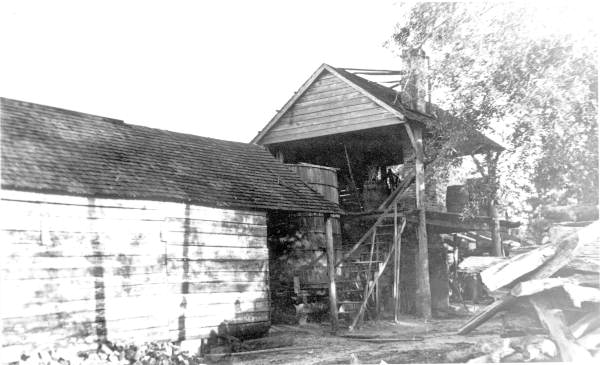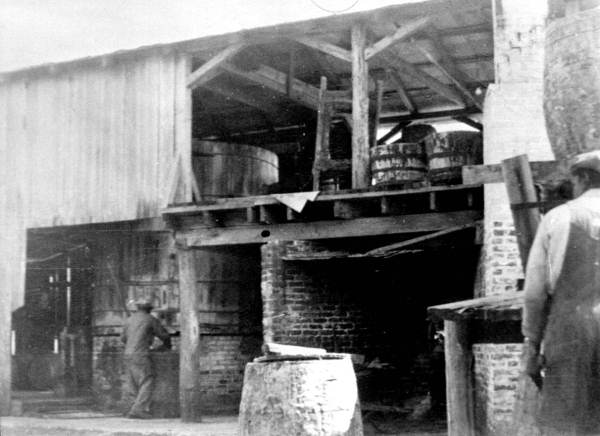|
Regional History History of Timbering County Histories Oral Histories |
History: Timbering in North Florida
Timeline: 1800s through 1950s
1830s
Joseph Forsyth and Andrew and Ezekiel Simpson (Forsyth and Simpson Arcadia mill) built one of the earliest sawmills in west Florida. Located near Pensacola, this water-powered mill was producing over 250,000 board feet of lumber per year (an average of seven hundred board feet per day) by the mid-1830s. By the end of the decade the mill sent out an average of over 900,000 board feet of lumber per year.
1840s
Efficiency and production were improved in the north Florida mills with the introduction of steam engines and circular saws.
1850s
The lumbering industry in north Florida was becoming well established. Most of the steam-powered mills in north Florida were similar: small, family owned mills with a roof covering the saw, steam engine and furnace which employed from six to eight laborers and produced about 300,000 to 450,000 board feet of lumber per year (about 1,300 board feet per day). These small mills were run by the owner and his family, with seasonal help being hired during peak production periods. Since hauling logs any distance was costly for the small mills in the interior of north Florida, these mills mainly served the local area.
Homestead Act of 1862
The Act granted adult heads of families 160 acres of surveyed public land if they improved and lived on the land for five continuous years. A “tree claim” could also be made if ten acres of timber was planted and successfully cultivated.
Southern Homestead Act of 1866
Encouraged whites and freed slaves to own farms of either 80 or 160 acres, the price of which was $5.00- for the farm, not for an acre. Most timberland at the time was selling for $1.25 an acre. (Walker, 1991)
1867
Leaving from Chicago, John Muir begins his long walk to Florida on September 5, 1867. He describes the extent of the longleaf pine forests in great detail in his writings.
1869
The first lumber census reported a mill tally for the South of 1.6 billion board feet for the year. By 1879 it had almost doubled.
1870-Franklin County
The beginning of Franklin County's timber industry starts with several small lumber mills. Timber supplies seemed endless and the industry began to grow. The timber industry would support a large portion of the area's economy for many decades.
1873
Despite the fact that loggers and sawmill workers in north Florida worked long hours with low pay, little opportunity for advancement and a high risk of serious injury, labor walkouts and strikes were not common and the ones that did occur were unorganized and uncoordinated. Sawmill workers attempted to strike at a Jacksonville mill in 1873, but after a month the strike was recognized as a failure. Some of the workers returned at pre-strike rates, others were replaced and left jobless.
1876
Due to hard times brought on by the Civil War, most southerners did not have the capital to purchase timberland. Timber speculators from the north came by the trainload to make their purchases.
The Timber and Stone Act of 1878
Transfer of public lands to private ownership did not require the property to be used for agriculture. Abuse resulted in soil erosion and watershed destruction which lead to its repeal, many years later, in 1955.
1880
The population of Florida had doubled since the end of the Civil War. Thousands of immigrants came to this still largely undeveloped area looking for employment or land, many were subsistence farmers or field hands from southern Georgia, southern Alabama, Mississippi and the Carolinas.
1880
Mill fires were reported weekly in the state's newspapers. These fires could shut down an entire plant, causing lost wages for the workers and affecting the operator's bottom line. Companies began posting “No Smoking” signs within their mills, but most were ignored. One account from the March 20, 1880 diary entry of an Apalachicola lumber mill superintendent by the name of Samuel Floyd read “Posted a sign in the mill according to instructions, “No Smoking”, I had a lighted cigar in my mouth at the time.” (Drobney, 1997)
1883
Lumber grading was first adopted by southern mills as a way to standardize the quality of the boards produced.
1886
The Knights of Labor, an organization for skilled lumber workers, were making successful inroads into organizing the north Florida lumber industry. Membership increased from 104,066 to 702,924 between 1885 and 1886. Outbreaks of strikes occurred as organizers moved into the region, some of which resulted in temporary gains for the lumber workers. Local assemblies were organized in several north Florida counties including Franklin and Jackson, yet by 1893 all of them ceased to exist. Few details of the social activities or labor organizing activities of these assemblies were recorded. Internal feuding tore apart the Knights in Florida from the mid-1880s to the early 1890s and by 1892 the General Executive Board of the Knights of Labor revoked the state charter. The Knights regrouped in northwest Florida for a short time, but disintegrated after 1902.
1888
Chicago investors had purchased 122,000 acres in Florida for as little as 25 cents per acre. Tracts in other southern states were transferred for about the same price. By 1892, yellow pine and southern bald cypress imported to the North totaled a hundred million feet annually.
Late 1890s
Part-time seasonal workers were becoming a thing of the past. North Florida sawmills were now employing more permanent workers, and by 1910 many of them had never known any other occupation.
1900
 A turpentine still on the Woodville Road, Wakulla County, circa 1920 |
1903
With northern timber companies buying up private and public lands, poor blacks and whites were left unable to purchase land. Work in the forests offered better opportunities than the agricultural jobs that many southern men traditionally held, so despite the dangerous conditions, low pay and long hours, many of these men were giving up farm work and making a career of lumbering. The pay rate for laborers in north Florida sawmills was 10.5 cents per hour. By 1907 it had increased to 13.67 cents per hour, still far less than their northern counterparts were making. (Drobney, 1997)
1908
 Young boy collecting resin |
Resin production peaked. |
1900-1910
A “car house” rented for four dollars a month. These crude, portable homes were made from remodeled boxcars that were lifted from the tram tracks, set down a few feet from the right of way and fitted with windows for the loggers and their families. Tents and cabins were also used for housing in the camp towns, the company store, physician's office and other services were housed in these portable quarters as well.
1909
Peak period for the exploitation of the southern forest. More than 16 billion board feet of lumber was produced in those twelve months (45% of the total U.S. harvest). (Tebo, 1985)
1917
Worker's Compensation and the various problems confronting labor were high priorities in the newly elected administration of Florida Governor Sydney Catts. Numbers of injured workers had attempted to sue their employers for work related injuries, but few received any type of settlement. Harsh resistance from businessmen in the lumber industry delayed the passage of workmen compensation legislation until the 1930s.
1918
The Southern Pine Association began its “Safety First” campaign due the huge number of mill accidents that were leaving the workers severely injured, maimed and in many cases dead.
Early 1920's
 A still near Apalachicola, Franklin County, circa 1920 |
1924
Clarke-McNary Act authorized the government to acquire those lands with the most potential for timber production and develop them as demonstration areas. The U.S. Forestry Service, along with the American Forestry Association began a campaign to educate the public on timberland management. The Dixie Crusaders, as they were known, traveled all over the southern backwoods with their exhibits.
1925
Edward Ball began buying large tracts of land for timbering with funds that he and brother-in-law Alfred I. du Pont had earned by investing in failed banks during the Depression. His initial purchase was 66,000 acres, but he ultimately acquired one million acres.
1932
A Georgia chemist by the name of Charles Herty developed a chemical process to make paper out of southern pine. As word spread about this new process, pulp mills began to spring up all over the south. The demand for pulpwood land increased and land prices began to rise.
1932
Ornithologist Herbert Stoddard's publication titled The Bobwhite Quail, Its Habits, Preservation and Increase, which came out in 1931, helped convince the Forest Service that suppressing fires was harming the longleaf forests and was one of the reasons that the bobwhite quail populations were in decline. By the 1940's the Forest Service instituted what they called “prescribed” burning and began to apply fire management to forest lands.
Mid-1930s
The vast virgin pine and cypress forests that had covered north Florida were nearly depleted. Reforestation was not a common practice, and if it was used, the timber could not be harvested for another twenty years.
1936
The St. Joe Paper Company was formed as part of Edward Ball's dream of a model community a year after Alfred du Pont's death. The paper mill began operations in 1938 in Port St. Joe, employing hundreds of workers. It was sold and shut down in 1999.
1937
Paul Hursey was hired as one of the South's first professional foresters. His job responsibilities included fighting fires, marking timber for cutting, making management plans and laying out railroad trams. Foresters in state agencies conducted tours and gave demonstrations for the industrial leaders so that they could better manage their lands and increase their income.
1940s
Soil conservation districts were organized. Foresters in the Soil Conservation Service, as well as those in the state and Agricultural Extension Service, gave programs to landowners that sought expert advice on the management of their woodlands. They also educated the public throughout the region with their publications, programs and demonstrations.
Late 1940s
As the last great trees were cut, lumber production began to slow and then ceased altogether in many of the company towns. These once thriving company towns were dismantled and the company culture they spawned died with them.
Note: The content of the website has not been updated since 2005. The site remains online for it's value as legacy content and is unlikely to be updated.